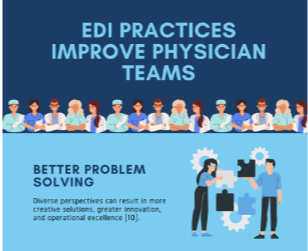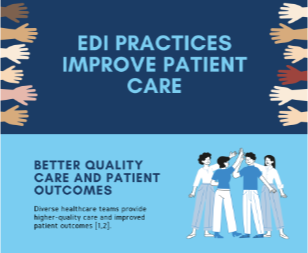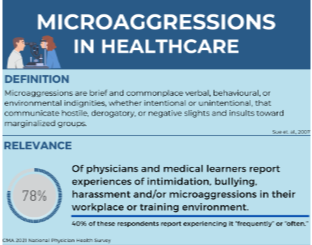
Equity, Diversity and Inclusion Resources
We recognize the importance of promoting a more inclusive and diverse community of ophthalmologists, and we’re committed to providing valuable resources to support our members in this journey including a glossary of EDI terms, online resources, and infographics.
By embracing EDI principles, we can create a more equitable and welcoming environment for patients and professionals alike. As you engage with our resources, remember that embracing these principles not only benefits your own professional development but also enhances the quality of patient care.
We invite you to actively participate in promoting EDI within ophthalmology. Share your insights, experiences, and suggestions to help us expand our resources and support for the community.
Infographics
Resources
Glossary of EDI Terms:
Understanding the language of EDI is an essential first step in promoting inclusivity and diversity within your practice. Explore our short glossary of key EDI terms.
Accessibility:
The extent to which a facility or resource is readily approachable and usable by marginalized individuals, or individuals with disabilities.
Ally:
A person who is not a member of a marginalized or disadvantaged group but who expresses or gives support to that group. Allyship is the support for the interests of a minority or marginalized group without being a member of that group.
Belonging:
Everyone is treated and feels like a full member of the larger community and can thrive.
BIPOC:
Black, Indigenous, People of Color. BIPOC commonly refers to individuals who are not considered white.
Cisgender:
A person who identifies as the gender they were assigned at birth. (contrast with “transgender”).
Diversity:
The myriad of shared and different personal and group characteristics among human beings. With diversity, there is ideally proportionate representation across all dimensions of human difference.
DEI:
Diversity, equity, and inclusion.
EDI:
Equity, diversity, and inclusion. Some prefer the term EDI to DEI rationalizing that without equity, diversity and inclusion are difficult to accomplish.
EDIIA:
Equity, diversity, indigeneity, inclusion, accessibility.
JEDI:
Justice, equity, diversity, and inclusion.
Ethnicity:
A social construct which divides individuals into smaller social groups based on common cultural attributes such as language, religion, or nationality. (contrast with “race”).
Equality:
Providing the same to all or treating everyone the same. (contrast with “equity”).
Equity:
Fairness and justice. Equity recognizes that we do not all start from the same place and acknowledges and adjusts imbalances. Equity promotes the distribution of assets such that everyone has the resources they need to succeed. (contrast with “equality”).
Implicit bias:
The attitudes, prejudices, and judgments we make about individuals or groups that are ingrained in our subconscious due to our experience, upbringings, and backgrounds.
Inclusion:
The authentic incorporation of all individuals and groups, especially those that have been traditionally excluded into processes, activities, and decision/policy making in a way that shares power.
Inclusive Language:
Non-sexist language or language that considers all persons in its references. e.g., “a doctor should check the lab work on his patients” excludes female physicians. It would be more appropriate to say “doctors should check on the lab work of their patients”.
Indigeneity:
The quality of a person’s/groups’ fact of originating or occurring naturally in a particular place with knowledge and respect for original ways.
Intersectionality:
The cumulative manner in which multiple forms of marginalization /inequality (economic, physical or mental disability) and discrimination (such as racism, sexism, and classism) combine, overlap, or intersect to affect individuals or groups.
LGBTQ2S+:
An acronym for Lesbian, Gay, Bisexual, Transgender, Queer or Questioning, and Two-Spirit (a person that identifies as having both a masculine and feminine spirit) with all other queer identities that are not encompassed by the letters themselves being represented by the “+”.
Marginalized:
Relegated to an unimportant, ignored, or powerless position within a society or group.
Microaggressions:
Common daily verbal/non-verbal, behavioural, or environmental indignities, whether intended/unintended that connote derogatory, hostile, or negative messages against marginalized persons or groups (e.g., racial, LGBTQ+, elderly, religious groups, people with disabilities, immigrants).
Gender pronouns:
Are the personal pronouns that people ask others to use in reference to themselves to promote respectful communication. They may be plural gender-neutral pronouns such as they, them, and their(s). Or they may be ze (rather than she or he) or hir (rather 3 than her(s) and him/his). Some people state their pronoun preferences as a form of allyship.
Privilege:
An unearned, sustained advantage that comes from race, gender, sexuality, ability, socioeconomic status, age, nepotism, or other differences.
Race:
Race is a social construct used to categorize people based on perceived differences in physical appearance, forming discrete categorizations lacking a biological basis.
Transgender:
Person(s) whose gender identity is discordant with the sex registered for them at birth.
URM:
An abbreviation for Under-Represented Minorities.
References
- Harvard Human Resources. Glossary of Diversity, Inclusion and Belonging Terms. https://edib.harvard.edu/files/dib/files/dib_glossary.pdf
- Lu C, Ahmed R, Lamri A, Anand SS. Use of race, ethnicity, and ancestry data in health research. PLOS Global Public Health. 2022 Sep 15;2(9):e0001060.
- Merriam-Webster.com. 2023. https://www.merriam-webster.com (Mar 19, 2023).
- American Psychological Association. APA Publishing’s Equity, Diversity, and Inclusion Toolkit for Journal Editors. 2022
Incorporating EDI Principles into Your Organization or Team:
Learn how to foster an inclusive environment by understanding and implementing Equity, Diversity, and Inclusion principles.
Equity and diversity in medicine – Canadian Medical Association: The objective of this policy is to provide guidance to physicians and institutions by identifying a set of guiding principles and commitments to promote equity and diversity in medicine (as defined in the Guiding Principles section).
Canadian Centre for Diversity and Inclusion Toolkits: Toolkits of various EDI topics such as strategies to promote EDI in leadership, responding to social issues, bias, and discrimination.
Equity, Diversity and Inclusion Toolkit – Doctors of Nova Scotia: Tools for assessing power relationships, how to incorporate EDI into HR, allyship and ways to intervene in a workplace, amongst other key topics.
Improving Diversity, Equity, and Inclusion in Ophthalmology – American Academy of Ophthalmology: Opinion piece on how to improve diversity and address barriers to improving the underrepresentation of students in medicine and ophthalmology.
Equity, Diversity, and Inclusion Committees: Getting Started Guide – University of British Columbia: The purpose of this guide is to provide an overview of the role that EDI committees can play, and offers guidance for developing one within your division, unit, or department.
Toolkit on equality in governance structures, procedures and implementation: This Toolkit provides support for integrating EDI in governance principles of complex, large-scale, international, publicly funded research infrastructures (CoLIPRIs) and projects, like EBRAINS or the HBP.
Integrate EDI principles in your governance tools – EDI TOOLKIT: This website breaks-down the CoLIPRI toolkit (see above) into simple, digestible parts.
Lee, E. Y., Farrokhyar, F., Bakshi, N., Levin, L. A., & Ahuja, N. (2022). Equity, diversity, and inclusion landscape in Canadian postgraduate medical education for ophthalmology. Canadian Journal of Ophthalmology. https://doi.org/10.1016/j.jcjo.2022.08.015
Physician Leadership Toolkit for Encouraging and Promoting Diversity and Inclusion – Alberta Medical Association: Topics covered include how to foster diversity and inclusivity, inclusive language guide, and recognizing and mitigating bias.
Creating an Equitable, Diverse and Inclusive Research Environment: A Best Practices Guide for Recruitment, Hiring and Retention – Canada Research Chairs
EQUITY AND INCLUSION TOOLKIT – Canadian Federation of Nurses Unions: Includes environmental scan checklists, sample accessibility event checklists, sample workshops, amongst other resources.
Anti-Racism:
Discover strategies and resources for addressing and combating racism within your organization or team.
Anti-Racism Resource Guide: Becoming an Inclusive Leader – The University of Iowa: This guide serves as a starting point for leaders looking to develop their education about racism, and awareness of their own implicit biases
Anti-racism resources for white people – BC College of Family Physicians
The BIPOC Project – A Black, Indigenous, & People of Color Movement: The BIPOC Project aims to build authentic and lasting solidarity among Black, Indigenous and People of Color (BIPOC), in order to undo Native invisibility, anti-Blackness, dismantle white supremacy and advance racial justice.
In Plain Sight – Addressing Indigenous-specific Racism and Discrimination in B.C. Health Care: In June 2020, claims surfaced about a “Price is Right” game allegedly being played in some B.C. hospital Emergency Departments (EDs) in which health care workers were guessing blood alcohol levels of Indigenous patients. This report is intended to investigate these allegations and other forms of indigenous-specific racism across the province.
Romano M. J. (2018). White Privilege in a White Coat: How Racism Shaped my Medical Education. Annals of family medicine, 16(3), 261–263: Visit Resource
Implicit Bias:
Explore the impact of unconscious bias and ways to mitigate its effects in your workplace.
Implicit Bias Test by Project Implicit Health (PIH) – Harvard University: At Project Implicit Health (PIH), you can measure your thoughts about mental and physical health that are difficult to consciously control. The tests require less than 15 minutes, and you will receive feedback about your performance and learn more about your automatic thoughts.
The Diversity and Inclusion Innovation Forum: Unconscious Bias in Academic Medicine – AAMC: This report serves as a framework for understanding the impact of unconscious bias in academic medicine.
MITIGATING IMPLICIT BIAS IN HEALTH CARE – The Ohio State University: The Kirwan Institute has created this website to help practitioners consider the concept of implicit bias and explore its operation in medicine with a focus on clinical education and patient care.
Unconscious Bias: From Awareness to Action – CatalystX Online Module: This online module teaches in-demand leadership skills necessary to manage unconscious bias in your workplace. It is free and should take 3-6 hours to complete the entire course.
Blair, I. V., Steiner, J. F., & Havranek, E. P. (2011). Unconscious (implicit) bias and health disparities: where do we go from here?. The Permanente journal, 15(2), 71–78: The purpose of this guide is to provide an overview of the role that EDI committees can play, and offers guidance for developing one within your division, unit, or department.
Microaggressions in Healthcare:
Recognize and address microaggressions that occur in healthcare settings, fostering a more respectful environment.
Torres, M. B., Salles, A., & Cochran, A. (2019). Recognizing and Reacting to Microaggressions in Medicine and Surgery. JAMA surgery, 154(9), 868–872: Visit Resource
Molina, M. F., Landry, A. I., Chary, A. N., & Burnett-Bowie, S. M. (2020). Addressing the Elephant in the Room: Microaggressions in Medicine. Annals of emergency medicine, 76(4), 387–391: Visit Resource
ierce C. M. (1970). Black psychiatry one year after Miami. Journal of the National Medical Association, 62(6), 471–473. Journal article published by Harvard University psychiatrist Chester M. Pierce in 1970, whereby the term microaggression was first coined: Visit Resource
Sue, D. W., Capodilupo, C. M., Torino, G. C., Bucceri, J. M., Holder, A. M., Nadal, K. L., & Esquilin, M. (2007). Racial microaggressions in everyday life: implications for clinical practice. The American psychologist, 62(4), 271–286: Visit Resource
Miller, S. M., Maul, T. M., & Wei, J. L. (2023). Physician experiences of workplace racial and gender microaggressions. International journal of pediatric otorhinolaryngology, 168, 111516. Advance online publication: Visit Resource
Strategies to Approach Microaggressions:
Gain practical techniques and insights for effectively addressing and reducing microaggressions in your organization.
OTFD: Open the Front Door to Communication: Skip to page 4-5. This framework also available as a Slideshow Presentation or handout.
Responding to Microaggressions in the Classroom: Taking ACTION: Framework also available in the form of an Infographic.
Six Techniques for Speaking Up: Calling people “In” not “Out”: Visit Resource
Resources for Conducting Research:
Access tools and references for conducting research that promotes Equity, Diversity, and Inclusion in your field.
Guidance on the Use of Standards for Race-Based and Indigenous Identity Data Collection and Health Reporting in Canada – Canadian Institute for Health Information (CIHI): Visit Resource
Stanbrook, M. B., & Salami, B. (2023). CMAJ’s new guidance on the reporting of race and ethnicity in research articles. CMAJ : Canadian Medical Association journal = journal de l’Association medicale canadienne, 195(6), E236–E238: Visit Resource
Resources for Medical Education and Residency:
Discover educational resources and strategies for integrating EDI principles into medical education.
BEST PRACTICES IN APPLICATIONS & SELECTION (BPAS) – BPAS WORKING GROUP: Following a comprehensive literature review and environmental scan to develop recommendations, this report outlines 13 principles and 20 best practices developed for residency programs at UofT, but is applicable to all programs across Canada: Visit Resource
AAMC Interview Guidance for the 2022-2023 Residency Cycle: Guidance on conducting exclusively virtual interviews for residency programs: Visit Resource
Ing EB. The use of an analytic hierarchy process to promote equity, diversity and inclusion. Can J Surg. 2022 Jul 5;65(4):E447-E449. doi: 10.1503/cjs.013521. PMID: 35790243; PMCID: PMC9337865: Visit Resource
Economics & EDI:
Explore the economic aspects of Equity, Diversity, and Inclusion, and how they impact your organization or team.
LaVeist TA, Pérez-Stable EJ, Richard P, et al. The Economic Burden of Racial, Ethnic, and Educational Health Inequities in the US. JAMA. 2023;329(19):1682–1692: Visit Resource
Videos and TED Talks:
Access a collection of insightful videos and TED Talks that provide valuable perspectives and practical insights on Equity, Diversity, and Inclusion.
The Surprising Solution to Workplace Diversity | Arwa Mahdawi | TEDxHamburg: Watch
The urgency of intersectionality | Kimberlé Crenshaw | TEDWomen: Watch
Diversity and Inclusion Video Learning Series – Association of American Medical Colleges (AAMC): Watch
Belonging, A Critical Piece of Diversity, Equity & Inclusion | Carin Taylor | TEDxSonomaCounty: Watch
Other Resources on Equity, Diversity, and Inclusion:
Find additional valuable resources to deepen your understanding and implementation of EDI principles beyond the listed categories.
Diversity and Inclusion Education – American Academy of Ophthalmology (AAO): Visit Resource
Diversity and Inclusion Toolkit Resources – AAMC: Visit Resource
Equity and diversity in medicine – CMA: Resources, tools and information to help health care leaders eliminate gender bias and promote equity and diversity in health care settings: Visit Resource
EQUITY, DIVERSITY AND INCLUSION – College of Physicians and Surgeons of Ontario (CPSO): CPSO has compiled various resources on topics such as allyship, disability, discrimination against physicians, implicit bias, microaggressions, and racism:Visit Resource
Equity, Diversity & Inclusion – Doctors of BC: This resource provides an example of a “Barrier Assessment” on how to work towards achieving greater EDI within organizational governance bodies based on organizational members’ survey responses: Visit Resource



